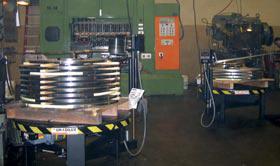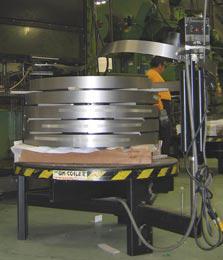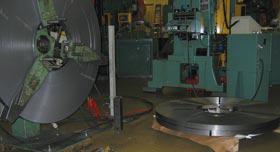Contributing Writer
- FMA
- The Fabricator
- FABTECH
- Canadian Metalworking
Categories
- Additive Manufacturing
- Aluminum Welding
- Arc Welding
- Assembly and Joining
- Automation and Robotics
- Bending and Forming
- Consumables
- Cutting and Weld Prep
- Electric Vehicles
- En Español
- Finishing
- Hydroforming
- Laser Cutting
- Laser Welding
- Machining
- Manufacturing Software
- Materials Handling
- Metals/Materials
- Oxyfuel Cutting
- Plasma Cutting
- Power Tools
- Punching and Other Holemaking
- Roll Forming
- Safety
- Sawing
- Shearing
- Shop Management
- Testing and Measuring
- Tube and Pipe Fabrication
- Tube and Pipe Production
- Waterjet Cutting
Industry Directory
Webcasts
Podcasts
FAB 40
Advertise
Subscribe
Account Login
Search
The big payoff
Pallet uncoilers help to reduce scrap, labor, and safety costs
- By Tim Malarky
- February 19, 2007
- Article
- Bending and Forming
Traditional slinging and hoisting of coils for mounting on vertical dereelers or positioning them in coil cradles requires extra personnel and is time-consuming because production must be stopped.
When a line isn't running—it's not making money.
To keep their lines moving, some stampers use a horizontal pallet uncoiler. Horizontal uncoiling calls for the placement of several palletized coils on top of each other on the uncoiler turntable. When the top coil runs out, the operator guides the next coil into the production machine's feeding mechanism. The coil changes continue using the pre-positioned coils until the bottom coil is emptied.
In some instances, palletized, horizontal coils can result in an average production time savings of 15 minutes per coil consumed—one hour for every four coils handled—when compared to the time it takes to load and unload coil from a vertical dereeler that might be used in similar feeding situations (seeFigure 1).
Let's take a look at some other areas to consider when it comes to horizontal pallet uncoilers.
Reducing Material Costs
Price pressures from the supply side and cost constraints on the job contract side have made reducing coil damage and material cost a critical business objective. Improvements made in material handling can translate into improvements of the bottom line.
Coils frequently are damaged in upending operations required on traditional vertical dereelers. For example, as a coil is lifted from the horizontal to a vertical position on the dereeler, the edges of the coil can be damaged or pinched when the coil rolls up onto its edge. This damage can extend several wraps deep into the coil. These coil wraps become instant scrap loss, good only for salvage.
Pallet decoiling is a way to avoid this type of coil damage because the coils never are hoisted into another position. Instead, they are delivered horizontally on a pallet, and the coils are placed on the horizontal uncoiler the same way.
Horizontal coil handling also may allow stampers to begin working with coils with larger outside diameters, because operators no longer need to lift and swing coils. Because a forklift lifts the pallet of coils, the size of the coils is less of an issue than if they were being lifted with hooks and slings. Stampers traditionally work with 24-inch- to 36-in.-OD coils; with larger coils, perhaps up to 72 in. OD, shops can run longer between changeovers.
The increased coil OD also will reduce a coil's unit cost. Material vendors have adjusted unit costs to reflect efficiencies gained by handling larger coils. Remember, the price advantage of switching from a 36-in.-OD coil to 60-in.-OD coil can be significant.

Figure 1In some instances, palletized, horizontal coils can result in an average production time savings of 15 minutes per coil consumed when compared to the time it takes to load and unload coil from a vertical dereeler that might be used in similar feeding situations.
Reducing Labor Costs
Coils used in a vertical orientation must be lifted from the pallet and guided into a cradle or positioned on the mandrel of a vertical dereeler. The job requires two people—one to operate the forklift or crane and another to guide and secure the coil. The job also can be done by one person, but, of course, the setup will take longer.
This type of coil lifting and positioning work can have negative impacts on many areas of staffing costs, such as the extra personnel needed and personnel diverted from other shop floor tasks. In union shops, the labor classifications may complicate this task; for example, one craft or labor grade, as determined by the union contract, may not be allowed to do this type of loading, and an employee in a separate labor classification may have to be present.
Horizontal coil handling on pallets can relieve some of these labor pressures. For example, because the pallet is loaded by forklift in one operation and the coils are not individually handled, shop personnel do not have to push, pull, or lift coils.
Related to the reduction in labor when it comes to loading a horizontal uncoiler is the possibility of reducing the need for jib cranes, bridge cranes, slings, and chains. In some jurisdictions, the cost of expensive, mandated safety certifications associated with cranes can be eliminated
Forklifts still are used for loading full pallets of coil, but they won't be used as much because the operator no longer has to move individual coils.
Reducing Safety Hazards
The savings associated with following safety practices sometimes are not readily quantifiable, yet the costs of accidents and injuries are always well-known.
Traditional coil placement involves lifting and swinging coils on hooks, slings, or bands (seeFigure 2). Shop personnel are exposed to strain injuries from pushing or lifting coils, lacerations from sharp strip edges, and potential serious injury from dropped coils. Even when powered equipment moves single coils, human labor still is required.
Pallet uncoiling eliminates unnecessary lifting and moving of individual coils. Once a forklift positions the pallet of coils, no further coil movement is necessary. Operators need only thread the strip end of each new coil to get one started. When the top coil runs out, the operation is repeated on the next coil, and so on. Coil-related injuries are much less likely because the coils are handled less.
Reducing Floor Space
The old pressroom landscape of vertical dereelers or cradles and their ever-present pallets of coils staged on the floor for single coil loading can take up precious floor space.
With a horizontal pallet uncoiler, the staged coils and the payoff are one in the same; they sit on the same floor space. In other words, coil inventory can be stacked on pallets for delivery to the uncoiler. Coil stock can be managed for clear inventory control and moved to the production line as needed.
About the Author
Related Companies
subscribe now

The Fabricator is North America's leading magazine for the metal forming and fabricating industry. The magazine delivers the news, technical articles, and case histories that enable fabricators to do their jobs more efficiently. The Fabricator has served the industry since 1970.
start your free subscription- Stay connected from anywhere

Easily access valuable industry resources now with full access to the digital edition of The Fabricator.

Easily access valuable industry resources now with full access to the digital edition of The Welder.

Easily access valuable industry resources now with full access to the digital edition of The Tube and Pipe Journal.
- Podcasting
- Podcast:
- The Fabricator Podcast
- Published:
- 04/30/2024
- Running Time:
- 53:00
Seth Feldman of Iowa-based Wertzbaugher Services joins The Fabricator Podcast to offer his take as a Gen Zer...
- Trending Articles
JM Steel triples capacity for solar energy projects at Pennsylvania facility

Fabricating favorite childhood memories

How laser and TIG welding coexist in the modern job shop

Robotic welding sets up small-batch manufacturer for future growth

Ultra Tool and Manufacturing adds 2D laser system

- Industry Events
Pipe and Tube Conference
- May 21 - 22, 2024
- Omaha, NE
World-Class Roll Forming Workshop
- June 5 - 6, 2024
- Louisville, KY
Advanced Laser Application Workshop
- June 25 - 27, 2024
- Novi, MI
Precision Press Brake Certificate Course
- July 31 - August 1, 2024
- Elgin,




























